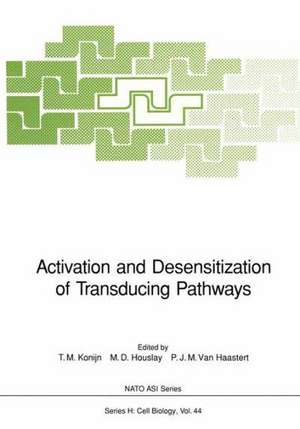Activation and Desensitization of Transducing Pathways: Nato ASI Subseries H:, cartea 44
Editat de T. M. Konijn, M.D. Houslay, P.J.M. van Haasterten Limba Engleză Paperback – 19 ian 2012
Din seria Nato ASI Subseries H:
- 18%
 Preț: 953.82 lei
Preț: 953.82 lei -
 Preț: 393.13 lei
Preț: 393.13 lei - 15%
 Preț: 643.34 lei
Preț: 643.34 lei - 15%
 Preț: 643.34 lei
Preț: 643.34 lei - 15%
 Preț: 641.03 lei
Preț: 641.03 lei - 15%
 Preț: 642.83 lei
Preț: 642.83 lei - 15%
 Preț: 642.51 lei
Preț: 642.51 lei - 5%
 Preț: 712.81 lei
Preț: 712.81 lei -
 Preț: 392.97 lei
Preț: 392.97 lei - 15%
 Preț: 651.02 lei
Preț: 651.02 lei - 15%
 Preț: 640.24 lei
Preț: 640.24 lei - 18%
 Preț: 948.61 lei
Preț: 948.61 lei - 15%
 Preț: 655.92 lei
Preț: 655.92 lei - 15%
 Preț: 655.92 lei
Preț: 655.92 lei - 15%
 Preț: 653.14 lei
Preț: 653.14 lei - 15%
 Preț: 650.19 lei
Preț: 650.19 lei - 15%
 Preț: 655.13 lei
Preț: 655.13 lei - 15%
 Preț: 652.17 lei
Preț: 652.17 lei - 15%
 Preț: 675.58 lei
Preț: 675.58 lei - 18%
 Preț: 958.07 lei
Preț: 958.07 lei - 18%
 Preț: 961.41 lei
Preț: 961.41 lei - 18%
 Preț: 970.56 lei
Preț: 970.56 lei - 5%
 Preț: 1100.30 lei
Preț: 1100.30 lei - 5%
 Preț: 376.43 lei
Preț: 376.43 lei - 15%
 Preț: 650.86 lei
Preț: 650.86 lei - 15%
 Preț: 644.63 lei
Preț: 644.63 lei - 15%
 Preț: 655.60 lei
Preț: 655.60 lei - 18%
 Preț: 963.47 lei
Preț: 963.47 lei - 15%
 Preț: 648.42 lei
Preț: 648.42 lei - 5%
 Preț: 731.43 lei
Preț: 731.43 lei - 15%
 Preț: 653.14 lei
Preț: 653.14 lei - 18%
 Preț: 960.13 lei
Preț: 960.13 lei - 18%
 Preț: 968.34 lei
Preț: 968.34 lei - 18%
 Preț: 953.97 lei
Preț: 953.97 lei - 15%
 Preț: 654.95 lei
Preț: 654.95 lei - 15%
 Preț: 652.49 lei
Preț: 652.49 lei - 15%
 Preț: 650.86 lei
Preț: 650.86 lei - 5%
 Preț: 367.64 lei
Preț: 367.64 lei - 5%
 Preț: 1104.68 lei
Preț: 1104.68 lei - 18%
 Preț: 953.20 lei
Preț: 953.20 lei - 15%
 Preț: 651.99 lei
Preț: 651.99 lei - 15%
 Preț: 647.27 lei
Preț: 647.27 lei - 15%
 Preț: 653.00 lei
Preț: 653.00 lei - 15%
 Preț: 656.25 lei
Preț: 656.25 lei - 18%
 Preț: 962.35 lei
Preț: 962.35 lei - 15%
 Preț: 666.55 lei
Preț: 666.55 lei - 15%
 Preț: 642.68 lei
Preț: 642.68 lei - 15%
 Preț: 645.96 lei
Preț: 645.96 lei - 15%
 Preț: 651.84 lei
Preț: 651.84 lei
Preț: 644.82 lei
Preț vechi: 758.60 lei
-15% Nou
Puncte Express: 967
Preț estimativ în valută:
123.38€ • 129.17$ • 102.09£
123.38€ • 129.17$ • 102.09£
Carte tipărită la comandă
Livrare economică 05-19 aprilie
Preluare comenzi: 021 569.72.76
Specificații
ISBN-13: 9783642836206
ISBN-10: 3642836208
Pagini: 340
Ilustrații: XI, 320 p.
Dimensiuni: 170 x 242 x 18 mm
Greutate: 0.54 kg
Ediția:Softcover reprint of the original 1st ed. 1990
Editura: Springer Berlin, Heidelberg
Colecția Springer
Seria Nato ASI Subseries H:
Locul publicării:Berlin, Heidelberg, Germany
ISBN-10: 3642836208
Pagini: 340
Ilustrații: XI, 320 p.
Dimensiuni: 170 x 242 x 18 mm
Greutate: 0.54 kg
Ediția:Softcover reprint of the original 1st ed. 1990
Editura: Springer Berlin, Heidelberg
Colecția Springer
Seria Nato ASI Subseries H:
Locul publicării:Berlin, Heidelberg, Germany
Public țintă
ResearchCuprins
Chemotaxis and Chemosensing.- Activation and desensitization in bacterial Chemotaxis.- Adaptation of chemoattractant elicited responses in Dictyostelium discoideum.- The inositolcycle of Dictyostelium discoideum.- Cyclic Nucleotide-Coupled Systems.- Glucagon activates two distinct signal transduction systems in hepatocytes,which leads to the desensitization of G-protein-regulated adenylate cyclase, the phosphorylation and inactivation of Gi-2 and the phosphorylation and stimulation of a specific cyclic AMP phosphodiesterase.- Multiple pathways for glucagon-induced heterologous desensitization of liver adenylyl cyclase.- The mechanisms of luteinizing hormone-induced activation and desensitization of adenylate cyclase.- Role of protein kinases in the desensitization-sensitization of ?-adrenergic receptor and prostaglandin receptor stimulation of adenylyl cyclase.- Direct involvement of the cyclic nucleotide binding sites in the cyclic-nucleotide-induced charge shift of protein kinases.- Inositol Phospholipid-Coupled Systems.- Heterogeneity amongst myo-inositol derivatives: metabolism of second messengers and synthesis of co-signals.- Role of glycosyl-phosphatidylinositols in insulin signaling.- Agonist and guanine nucleotide regulation of P2Y-purinergic receptor-linked phospholipase C.- G-Protein Activation.- Mechanisms involved in G-protein activation by hormone receptors.- Visual Transduction.- Regulation and rapid inactivation of the light induced cGMP phosphodiesterase activity in vertebrate retinal rods.- Auxin-Coupled Systems.- Characterization and modulation of the sensitivity of plant protoplasts to auxin.- The auxin-binding-protein from maize coleoptiles.- Is a GTP-binding protein involved in the auxin-mediated phosphoinositide response on plant cellmembranes?.- Ion Conductance.- Regulation of the desensitization of the acetylcholine nicotinic receptor.- Cellular Systems.- The control of human thyroid cell function, proliferation and differentiation.- Activation of the regulated secretory pathway in neuronal cells during in vitro differentiation.











